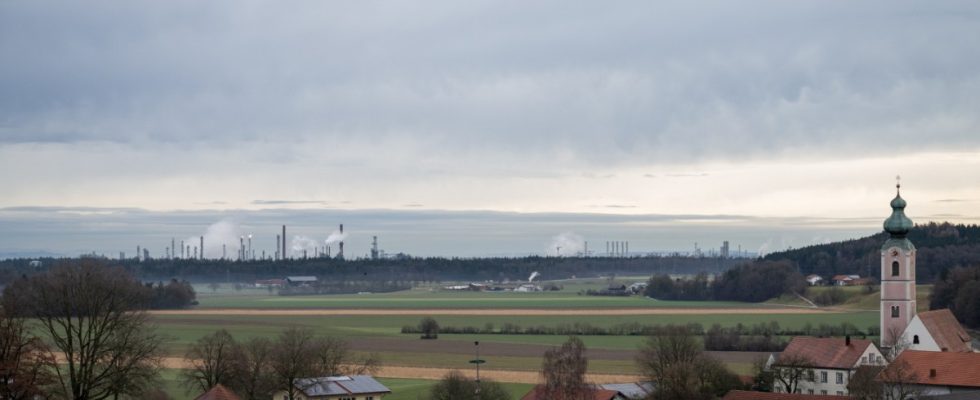The citizens of Mehring in the Altötting district have spoken out against wind turbines in their municipal area by a large majority. They rejected the plans in both a council decision and a referendum, as Mayor Robert Buchner (Free Voters) announced on Sunday evening upon request.
Bavaria’s largest wind farm is to be built in the Altöttinger Forest. With a total output of 288 megawatts, it will also supply the Bavarian chemical triangle with electricity. According to current plans, there should be ten of around 40 wind turbines in the Mehring area.
The council’s decision was rejected by 876 votes to 525; Here the citizens were asked whether they would support the planning and construction of the wind turbines. In the referendum, 928 eligible voters voted yes and 454 voted no. The question here was whether the community should do everything to prevent the wind turbines.
“It’s a shame that the majority were against it,” said Mayor Buchner. “I can’t yet assess how much impact this will have on the construction of the wind farm.” At least what was achieved was that the vast majority went to the polls: voter turnout was 75 percent.
Plans for wind turbines were recently underway in seven communities. The Mehring local council had already approved the project at the beginning of 2023. He will now request that the consent be revoked, said Mayor Buchner. “If the approval process comes about, we have to refuse our consent because the will of the citizens is binding.”
Referendum in Mehring.
(Photo: Catherina Hess)
The “Gegenwind Altötting” initiative, which initiated the citizens’ initiative, welcomed the result. “This shows that people are committed to their forest, their environment and their homeland,” commented Rainer Harböck from the initiative. “Now we can take the next steps with confidence.” Further citizens’ initiatives are planned in neighboring communities, including in Marktl on June 9th for the European elections.
“We have a very high demand for electricity here in the region around the Chemical Triangle. The more electricity that can be generated locally, the better it is,” Economics Minister Hubert Aiwanger (Free Voters) had previously warned – and expressed his hope for broad approval. Around 1.1 million euros would probably flow into the municipalities’ coffers every year. “In addition, there will be important impulses for local craftsmen, companies and restaurants if around half a billion euros are invested in the wind farm here.”
How much wind is enough?
Mehring’s mayor Buchner and most of the local councilors approved the project and therefore initiated the council’s request. The wind farm is important to secure jobs and maintain the business location, said Buchner.
The “Gegenwind Altötting” initiative, however, argued that the area was not suitable for wind power. “We are a designated weak wind area,” said Harböck. In the area there are average wind speeds of around 4.5 meters per second; 12 to 13 meters per second are necessary for sensible operation. In addition, large parts of the forest would have to be cleared, which would act as a protected forest, protect residents from emissions and noise from the chemical industry and clean the air.
The German-French company Qair, which is entrusted with the project, presents different figures. At the planned hub height of around 200 meters, the wind strength is 5.6 to 6.1 meters per second, said managing director Heike von der Heyden. “We are planning a new generation of systems.” They ran in winds of 3 meters per second to 25 meters per second. “We have enough wind to generate 550 million kilowatt hours per year with 200 full-load hours.”
Qair expects a good hectare of forest to be cleared for construction per wind turbine. In the long term, around three-quarters of a hectare per facility must remain forest-free, says von der Heyden. Forest must be replanted elsewhere to replace the cleared area.
The Association for Nature Conservation in Bavaria (BN) sees the wind project in Altötting positively. Forest areas are less suitable than open land. But: “In order to mitigate the climate crisis, we need a real energy transition, which has unfortunately been systematically prevented in Bavaria for years,” says state chairman Richard Mergner, referring to the 10H distance rule.
Only the relaxation of this rule, according to which wind turbines had to be ten times their height away from settlements, made new projects possible, which the state-owned company Bayerische Staatsforsten is now pushing forward in several forest areas in the Free State. Last but not least, the “Wind on Land Act” forces the Free State, which is lagging behind in wind power, to make land available for wind turbines – by 2030 this should be 1.8 percent of the state’s area. The Altötting district also has to make its contribution, according to the Ministry of Economics.

